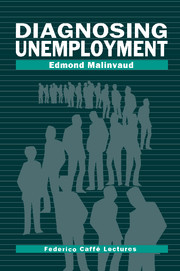Book contents
- Frontmatter
- Contents
- Preface to the Caffé Lectures 1990
- Acknowledgements
- Introduction
- 1 Expert diagnosis
- 2 Analysis and forecasting: their respective roles in mastering our destinies
- 3 From statistics to projections
- 4 Diagnosing unemployment trends
- 5 The Beveridge curve
- 6 Real wages and employment – a decade of analysis
- 7 Profitability and factor demands under uncertainty
- Index
4 - Diagnosing unemployment trends
Published online by Cambridge University Press: 06 July 2010
- Frontmatter
- Contents
- Preface to the Caffé Lectures 1990
- Acknowledgements
- Introduction
- 1 Expert diagnosis
- 2 Analysis and forecasting: their respective roles in mastering our destinies
- 3 From statistics to projections
- 4 Diagnosing unemployment trends
- 5 The Beveridge curve
- 6 Real wages and employment – a decade of analysis
- 7 Profitability and factor demands under uncertainty
- Index
Summary
In order to give a more concrete content to the considerations of chapter 1 and to complement them, it is necessary to select one particular subject on which one will follow the various operations through which diagnoses are eventually formed. Unemployment is obviously the subject to be selected on this occasion: it is the most acute macroeconomic problem in our European countries during this long period that started fifteen years ago and is not yet over. I have spent a good deal of my time on the subject over these past years; above all Professor Federico Caffé frequently expressed his concern about it and considered it one of the main reasons why economists had to advise governments.
Clearly diagnosing unemployment trends is difficult. The origins of the various uncertainties will clearly appear, I hope, in what follows. So much so that my presentation may even convey a distressing feeling: the difficulties might be taken as opposing an insuperable obstacle to attempts at diagnosis. In order to avoid this misunderstanding, to which many independent published statements give credit nowadays, I think it is necessary to state, right at the beginning of this lecture, that the past record is not as bad as some people say. I do not know of any systematic confrontation of the diagnoses given during the past two decades with what was later observed; but I think I know the situation well enough to give my own testimony with confidence.
- Type
- Chapter
- Information
- Diagnosing Unemployment , pp. 62 - 94Publisher: Cambridge University PressPrint publication year: 1994



